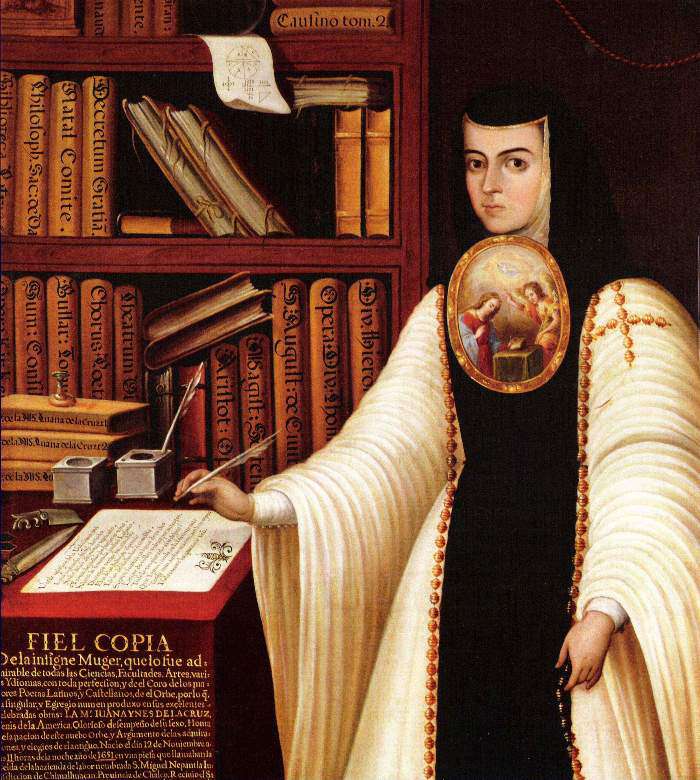In San Miguel Nepantla, 80 km from Mexico City, there is a monument dedicated to a woman who we can define as the first feminist of the New World. It is a bust made in 1951 by the sculptor Arias Méndeze dedicated to a nun of the order of Saint Jerome of the Immaculate Conception, the beautiful Sor Juana Ines De La Cruz.
The bust placed not far from the birthplace is inserted in a modest construction of stucco and stone and where four of the sonnets written by her are shown on the tiles.
Juana Inés knew both love and glory as reported in one of her sonnets "If you have succeeded in making yourself loved, you must resign yourself to the idea of being forgotten, but at least you have had the glory".
She was so beautiful that she was among the most courted girls in the sumptuous viceregal court of seventeenth-century New Spain; but she was also so talented and witty that she became the author of essays and plays. As a nun and woman of letters she worked to be the spokesperson for the women of her time, who were denied freedom and culture.
She was born in 1691, illegitimate daughter of the Spanish captain Pedro Manuel de Asbaje and a creole named Isabel Ramírez de Santillana. The little girl immediately lived with her maternal grandfather and she loved to roam free in the countryside. She had a solitary temperament and she spent hours and hours in her grandfather's library leafing through volumes and volumes. At the age of three she already knew how to read and at the age of five she composed the first verses and a drama which was staged in the village parish. At the age of ten, with her mother's permission, she was enrolled in the University of Mexico, and since she was only for boys, she dressed up as a boy and went to live with her uncles in Mexico City. Stubborn to the point that she learned Latin and Portuguese at 12 and every time she couldn't get what she set for herself, she cut off a lock of her hair saying "It is useless to dress up a head devoid of the most desirable ornament: knowledge".
Young, beautiful and able to hold excellent conversation in the capital world, to the point that the Marquis de Mancera He wanted her, then thirteen years old, as his wife's maid of honor. In this refined environment she was not insensitive to the charm of the life of the nobility which helped her to become famous precisely with her literary production.
There was no shortage of constant requests for new compositions, poems or plays, which were her lifeblood. Even if she sometimes, out of envy of the literati of the period, she murmured "Will it ever be possible for a simple girl to have the impudence to give herself the airs of a scholar?”.
The gossip also reached the ears of the viceroy who wanted to put her to the test, to verify if everything was staged as he heard or was it really a true gift from God, as he himself thought. He invited 40 scholars from the university to examine the girl in various disciplines.
With an uncommon dignity for a fifteen-year-old, she entered with her elegance and sat next to the professors who examined her for several hours. Juana passed each test with great ease and the viceroy said "It was like seeing the royal galleon being attacked by a handful of small boats".
But the environment was increasingly close to her, she was aware of the pettiness that surrounded her, so she decided to take the veil and enter the convent of the barefoot Carmelites. But the rigor of fasting and penance, too rigid for her body, led her to fall ill and it was there that, following the advice of her confessor, she changed her order with that of Saint Jerome of the Immaculate, much less severe than her .
But why should a particularly beautiful girl, with red lips, perfect white teeth, golden complexion and tapering hands, ever shut herself up in a convent?
According to biographers of the period, the choice was also due to a sentimental disappointment accompanied by a very profound literary vocation which in any case led her to isolate herself from the world. In her cell, full of books, Sor Juana wrote essays, poems, religious works and also composed splendid Christmas carols.
Despite his retired life, his fame was sought after and known inside and outside the borders of the Spanish Empire. Every year she received visits from men of letters and scientists who shared studies and research with her, in exchange she tried to give them valuable advice.
She also invented a system of musical notation and became a miniaturist, but was also well versed in theology, morals, canon law, astronomy and medicine. Inevitably, her wealth of knowledge created clashes with the ecclesiastical authorities, accusing her of excessive curiosity. She answered " To know God it is necessary to know man and his discoveries". And when he presented the first collection of love poems, the clergy cried foul.
Il Bishop Fernandez de Santa Cruz he reproached the author for her studies and for encouraging female vanity, and had the work published under another name, Sor Filotea de la Cruz.

Sor Juana replied to the bishop, Answer to Sor Filotea de la Cruz, it is a masterpiece. In support of her thesis, of not having to apologize for her intelligence, a gift from God, and above all of wanting to defend the right of every woman to follow an intellectual vocation, she quoted from the Bible characters of women who had the courage their vocations. And when it was said, according to widespread belief of the period, that a woman's ignorance was an aspect of holiness, she replied: "Isn't it perhaps due to superior intellectual abilities that the angel is superior to man? Is not man distinguished from the beast by his intelligence?”.
To the accusation of preferring profane topics to religious ones, he replied: "A heresy against art does not meet the anathema of the Holy Office, but only the laughter of the benevolent and the attacks of the critics".
She became a champion of women suitable to become good teachers and wrote: “Let us worry about keeping the ignorant rather than women from teaching".
It is not known what he suffered, but it is certain that he abandoned profane activities, sold his 4 books, all scientific and musical instruments, keeping only religious books. But what pressure had she ever received to give up his choices, his own life?
He confessed his guilt and pleaded for mercy in the divine court and gave himself to a life of mortification, he died of the plague at the age of 44.
In a single woman Mexico has seen brought together all the qualities that the Graces have bestowed on cultured women over the centuries, the great ornament of human history” Don Siguenza y Gòngora.





